Compiled by Norman Addington norm1394@gmail.com
From information provided by:
Eugene Powell epowell555@aol.com
Bob Klein bobklein99@comcast.net
Mary Herring mherring2@hot.rr.com
Constance Quillen CQ33@aol.com
Clyde F. Connor, Sr connercj@cfw.com
Laban West landswest@yahoo.com
Larry Shiflett lfsofva@hotmail.com
Anthony Lawson yankdim@shentel.net
Edith Tanner edtan@exis.net
Vicky B. Hensley genecrazyvic@aol.com
Jeanette Pryor JPSCI82@aol.com
Anne F. Shifflett ShifAnne@aol.com
Michael Lawson HDSAT1@aol.com
BACK to Family Chart

NOTES
John Lawson and Eve Harnist
Submitted by Eugene Powell
- Owned 320
acres of land in 1844 in Rockingham Co., Va. Fire destroyed part of
Rockingham's records so we don't know when John obtained this property
- 1850, Rockingham Co., Va. Census, H of HH, age 81, gives place of birth as Maryland
- 20 January 1851, Signed Deed to Theophilus Lawson, Rockingham Co., Va
- Served with 58 Regiment, 2nd Battalion of Capt. John Miller and in 1815 was reported missing one muster and fined 75 cents. (Notes of Sylvia Jones-1997)
- Deed of 15 Feb 1880 Rockingham Co., George Herring and Margaret his wife, Mary A. Shifflet (widow) and Mary A. Wood (widow) dividing their interest (all eight
shares) in the John Lawson dec'd tracts of land. See deed.
Moses Lawson and Rebecca Baugher
Submitted by Eugene Powell
- Actual Marriage Date, 20 Dec. 1833, Original Marriage Book of Rev. John Gibson, Albemarle, Co., Va., published by The Virginia Historical Society, 31 Dec. 1923.
- Book-Abstracts of Executor, Administrator, and Guardian Bonds of Rockingham Co., Va., 1778-1864, Printed 1978. "21 May 1849, Decendant Nicholas Baugher, Administrator, Zebulon D. Gilmore, Bond $6,000, bondsmen, Lewis G. Long, Moses Lawson, Wm. B. Yancey."
- Moses was a miller by occupation
- Notes for Rebecca (Peggy) Margaret Baugher:
1833, Bond and note, states she is the daughter of Nicholas Baugher and widow of Isaac Goodall deceased, Willis Powell on bond with Moses Lawson. Moses and Willis both signed their own names
6 October 1882, Rockingham Co., Va., Rebecca
Lawson's Will recorded
David G. Lawson, son of Moses and Rebecca Baugher
Lawson
Submitted by Anthony Lawson
Moses and Rebecca Lawson's son, David G. Lawson , was murdered in 1875 while returning home from the mill. He was murdered at about the same location as the present Swift Run Pool and campground.. The story has it that David's wife, Louisa (Morris) (a.k.a Lucy Ann Morris) and her brother (Silas Morris) were accused and convicted of hiring Anderson Shifflett to kill David for a sum of $50. All three were convicted and sentenced to hang. Anderson Shifflett was hanged in Harrisonburg in October of 1877 for the crime (When
Anderson Shifflet was hung the first time, the rope broke; they then got another rope and dragged him back up on the platform) while the other 2 were to hang at a later date. They were convicted as a result of testimony of a Sam Hall ( a former lover of Louisa's). But shortly before the other 2 hangings were to take place the governor issued a stay of execution because it was proven that Hall's testimony was not at all reliable, in fact maybe it was a way to get rid of Louisa. Eventually both were pardoned and released. Silas remained in the area and raised his family, and Louisa moved to the DC area and became a nanny for the children of a Military Diplomat, and died in California. Another witness against them in the case, Burris Williams on his death bed asked for a notary for the purpose of confessing to the crime, but either died or couldn't talk after the notary arrived. It is said that Silas Morris also confessed to the crime to a minister on his death bed. Details of this murder can be found in the book The David G. Lawson Murder (1875) & Ensuing Trial of Anderson Shifflett, Louisa Lawson, Silas Morris & Burris Williams (1877) by Larry Shiflett
Louisa Lawson and sons Moses and George
Submitted by Karol Lawson
David's wife, who your records name as Louisa May Morris, we known as Lucy Ann (Morris) Lawson. After her release from prison in Richmond she did not return to the Elkton area. She died in 1919 in California, and is buried at the cemetery at Mare Island Naval Shipyard (Vallejo, California), having worked for a number of years for the family of a naval officer stationed there. Her tombstone reads "Mrs. Lucy A. Lawson." As far as is known she had little or no contact with her children, George and Moses.
Moses was fostered in Harrisonburg (by the sheriff) and completed high school there. George, the elder, worked on a farm in the Elkton area. Moses in particular is described at length in newspaper stories about his father's murder and the subsequent trials. Moses left Harrisonburg about 1890 or 1891 and went to the Chicago area. He worked for the Chicago and Northwestern Railroad (promoted to engineer in 1899) for over 30 years. He married by at least 1900, Ella Koss, in Chicago. As far as we know, Moses had no contact with his Elkton relatives following his move to Chicago.
Moses and Ella had three children: Leslie Melvin Lawson (1901-1967) [my grandfather]; Bernice M. Schuler (b. 1904); and Lilas V. Maloney (b. 1908). Moses McClellan Lawson is buried, with his wife and some of their children and in-laws, in an old German cemetery on the west side of Chicago. All his grandchildren were born and raised in Chicago
Submitted by Karol Lawson
John and Eve had a son, Moses. He
had a son, David, who was murdered. He had two sons, one of whom, Moses, was
my great-grandfather. My father and I have continued
to research David's wife, Louisa (a.k.a. Lucy), who was implicated in his
murder. The following information is from primary sources [marriage records from
Greene County and
in Richmond at the Library of Virginia]:
David Lawson, a farmer and the son of Moses and "Peggy" [Rebecca Margaret
Baugher] Lawson, married Louisa Morris [born ca.
1841/2], daughter of Jefferson William Morris and Lusenna
[Shiflett] Morris, 24 May 1863. They were married by Rev. Casper
Allemony in Greene County. Louisa's parents:
Jefferson William Morris (born ca. 1817/18 in Orange County, Va.) [present
day Greene was part of Orange] married Lusenna
Shiflett [also spelled in records Lewany and several
other variants] (born ca. 1819/20 in Orange County, daughter of John Shiflett
and Rhoda---) on 23 July 1840. Louisa (a.k.a. Lucy) was their first child.
As you know, and have recorded on the Klein-Shiflett web site, from other
sources, Louisa was tried and convicted for David's murder. She was, at first,
sentenced to hang. However, given her gender and the circumstances of her life
with David (he seems to have been an abusive husband),
her sentence was commuted to life in prison. The Virginia
State Penitentiary Register of Convicts vol. no. 5 records that she was received
at the prison
December 9, 1877.
Following an ardent campaign to obtain a pardon for her, led by the
Commonwealth's Attorney, John Paul, and several other leading citizens and legal
figures in Rockingham County (many of whom had been jurors at her
trial)---including the trial's presiding judge, Charles
O'Farrall, and figures such as the Harrisonburg mayor, Pendleton Bryan,
the sheriff and its U.S. postmaster, as well as editors of the local newspaper
and a number of lawyers--Louisa was pardoned by Governor William Cameron on June
20, 1884 and was released from prison. We do not know what Louisa did
immediately after her release. We do know David's farm had been bankrupted and
was seized by the county (around the time of the trial). We do not know if
Louisa communicated with anyone in her family. We do know that she worked for
the family of Commodore Stacy Potts, U.S. Navy, for decades.
She lived in the Potts home, now a registered historic property, in Vallejo,
California, and is buried next to Commodore Potts' wife in the cemetery at Mare
Island Naval Shipyard.
I find it interesting to note that while Louisa had numerous sisters and
brothers none came forward to petition on her behalf. Likewise, while the young
Moses and his brother George, her sons, had numerous uncles, aunts, and cousins
in the Elkton and Swift Run areas, and perhaps too in Greene County, apparently
none of them came forward to care for the boys. As I have noted before, Moses
left Harrisonburg in about 1890 or 1891. We have school books Moses bought in
Harrisonburg as
well as receipts for classes at the high school there. In newspaper accounts of
his father's murder trial, Moses, about seven at the time, is described as "an
exceptional specimen, of winning ways...a boy of fine
countenance and regular features, industrious, upright and trustworthy...he is
very fond of books." Judge O'Farrall's memoirs noted
that Rockingham's sheriff, David Ralston, "adopted" Moses, who was "a good
student, progressing rapidly, stood high in his classes and carried away many
honors."
Elizabeth Lawson and David Wyant
Submitted by Eugene Powell
- 1826, Bond and note state that Elizabeth Lawson is the daughter of John Lawson, Moses on bond with David Wyant. Found Bond in Rockingham Co., Va.
- Actual Marriage Date, 5 Dec. 1826, Original Marriage Book of Rev. John Gibson, Albemarle, Co., Va., published by The Virginia Historical Society, 31 Dec. 1923.
- 21 April 2000, The Thomas A. Wyant Cemetery (Plaque erected in 1971) was visited by Norm Addington, Earl Atkins, and Eugene Powell. Tombstone inscriptions are still mostly visible on both David and Elizabeth's tombstones. "David Wyant, died 14 July 1882, age 76 years, 9 months, 26 days; Elizabeth Lawson Wyant, died 6 February 1890, age 83 years, 7 months, 16 days." David buried Thomas A. Wyant Cemetery, Beldor, Rockingham Co., Va., located on property now owned by Gordon A. Wood.
Joseph William Lawson, Sr and Lina Snow
Submitted by Eugene Powell
- Actual Marriage Date, 17 Feb. 1835, Original Marriage Book of Rev. John Gibson, Albemarle, Co., Va., published by The Virginia Historical Society, 31 Dec. 1923
- Joseph and his wife, Salina buried Mitchell Davis Cemetery, Greene Co., Va
Alfred William Lawson and Frances Wyant
Submitted by Eugene Powell
- Actual Marriage Date, 10 Aug. 1834, Original Marriage Book of Rev. John Gibson, Albemarle, Co., Va., published by The Virginia Historical Society, 31 Dec. 1923.
Matilda Lawson and Jacob Hupp
Submitted by Eugene Powell
- 1900, Greene Co., Va., Census, living in son Zebedee Marshall HH, born November 1816, age 83, widowed, 4 of 15 children living
- Actual Marriage Date, 18 Jan. 1838, Original Marriage Book of Rev. John Gibson, Albemarle, Co., Va., published by The Virginia Historical Society, 31 Dec. 1923
- From Norm Addington: 1840 Newark Township, Licking County, Ohio census shows one daughter under 5 years old.
Mary Lawson and Kennell Shiflett, George Herring
Submitted by Eugene Powell
- Actual Marriage Date, 22 Mar. 1835, Original Marriage Book of Rev. John Gibson, Albemarle, Co., Va., published by The Virginia Historical Society, 31 Dec. 1923
- 1835, Bond and note listed Mary Ann Lawson's parents as John Lawson, Kennelly Shiflett, was of Orange Co., Va., and son of Edward Shiflett, with Nelson on bond and Witness of note.
- George Herring - 1900, Rockingham Co., Va., Census, H of HH, born December 1825, age 74, married 40 years. Also living in HH, grandchildren, Amanda Herring, born June 1887, age 12; Alice Herring, born April 1900, age 1/12.
- See Also: Debate submitted by Laban West 23 Feb 1999 RE: Charles Henry Davis, Columbia Jane Shifflett Herring, and Virginia Ann (Ginnie) Wood)
Nancy Lawson and Nicholas Shiflett/Herring
Submitted by Eugene Powell
- Actual Marriage Date, 11 January 1843, Original Marriage Book of Rev. John Gibson, Albemarle, Co., Va., published by The Virginia Historical Society, 31 Dec. 1923. He was listed as Nicholas Shiflett
- From Mary Herring: 7 November 2000 - I found a deed from John Lawson's heirs regarding the court fight with the abbott Coal Co. regarding the land John Lawson bought from Gambill out of the original land grant of 29,000 acres. The heirs are listed and Nicholas and Nancy HERRING are listed. So that is my proof. The Nicholas I was chasing and the Nicholas you already had are one and the same. I love the hunt!
Theophilus Lawson and Caroline Herring
Submitted by Eugene Powell
- Actual Marriage Date, 14 Apr. 1844, Original Marriage Book of Rev. John Gibson, Albemarle, Co., Va., published by The Virginia Historical Society, 31 Dec. 1923. NOTE: Marriage recorded in Albemarle, Rockingham and Greene Counties, Va., by Rev. Gibson.
- 1844, Bond and note states Caroline Herring, daughter of Polly Herring; Kennel Shifflett on bond with Theophilus Lawson.
- Caroline - 1900, Rockingham Co., Va., Census, H of HH, born September 1834, age 65, widow, 7 of 10 children living.
- From Norm Addington: March 10, 2002 Gordon Wood of Beldor advised that he was about 10-12 years old he and his dad (Joseph Wood) went up to the "Old Cally place" (Caroline Lawson's house) to remove some lumber from the old house to make a chicken shed. This was just before the Park tore down all of the homesites located in the park. He said the house was located about 1/2 mile from the top of Simmon Gap on the west side of the mountain and down in the hollow on the left side of Simmon Gap Road just before the first sharp curve.
- From Larry Shiflett: Rockingham Register newspaper, Jul, 31, 1903
MOUNTAIN TRAGEDY
Jesse
Lawson Shot and Killed by Burrus Shiflett - Bloody End of Bitter Feud:
News was received Tuesday of the murder of Jesse Lawson, which was committed in Shiflett's Hollow, (actually it was Blackwell Hollow) in Albemarle Co., not far from the Greene Co. line, Sunday night. It was stated that Burrus Shiflett fired the fatal shot, and he is now a fugitive from justice.
The details of the killing reached Harrisonburg through the Swift Run Gap people who had come to town as witnesses and interested parties in the Richards vs. Morris case, and they constitute a tale of mountaineer enmity and hatred worthy of the darkest regions of Kentucky and West Virginia.
It started with a woman in the case. Several years ago Lawson and Shiflett had a quarrel, and it was over a woman. Shiflett swore he would not die until he had laid low the man he hated. A year or two afterward Lawson arraigned in the courts charging with burning a barn. He was given two years in the penitentiary on the oath of Shiflett. He returned from Richmond, declaring to his friends that he had served his time as a innocent man, which afterward was proven to be true. A second time Shiflett's vengeance overtook him this time in the shape of a loaded buckshot, which, however, did not prove fatal.
Shiflett disappeared and became a virtual outlaw for a long time. Abt. a year ago he made his appearance again and shot Lawson again a second time, with like result. He was a fugitive from justice again until last week, when he came back into the Shiflett's Hollow country and in the presence of Lawson repeated his oath that he would kill him yet. Sunday night he made good his threat. Lawson had gone out of the house abt. 9 o'clock and on returning the fatal load of eight buckshot was fired into him. He lived abt. an hour after he was shot. The funeral took place Tuesday afternoon, which prevented his brother from
attending the Richards-Morris trial.
The Co. around the scene of the murder is one of the wildest in the Blue Ridge and Shiflett has so far eluded the pursuit of the law if, indeed, any effort has been made to apprehend him. Lawson's life was an eventful one. He had been shot five times - three times by Burrus Shiflett, once by Overton Shiflett, and once by Sanford Davis. He is said to have been a man of great physical courage, and that fear was a stranger to his composition. As Burton Morris put it, and Burton knew him intimately for many years, he was a man naturally of a peaceable disposition, but had been made desperate by stress of circumstances.
Shiflett had the reputation of being one of the most desperate men whose names are linked with criminal history of Shiflett Hollow.
- From Norman Addington: From the Greene Co. Daily Progress newspaper, Saturday, 1 Aug, 1903:
NOT IN SHIFLETT HOLLOW
CORRESPONDENT SAYS THAT CRIME WAS COMMITTED IN BLACKWELL
HOLLOW-
Former Place Not as bad as it is Represented
Neglect of Church and State
Largely
to Blame For the Conditions - No
Educational Advantages
Commenting on the murder of Jesse Lawson, this Co., on Sunday, night last, a correspondent at
Crozet writes as follows:
Last Sunday night in Blackwell Hollow a horrible crime was committed. One Jesse Lawson was shot by one
supposed to be Burruss Shifflett. As I was near the scene of the murder from the time it was committed until the victim was bur., heard the matter discussed pro and con by the people of that section, I wish through the column of your newspaper to clear up, if possible, a few mistaken ideas on the part of people outside concerning that section, and to offer a few suggestions as to how I think such a horrible crime can be stopped and the fair name of Albemarle Co., saved the disgrace of such shocking conduct.
The murder has been placed upon Shifflett's Hollow when as matter of fact it took place in Blackwell Hollow abt. two miles from Shifflett's. That entire section of Co. has been considered by people living outside as one in which the life of a stranger would not be safe. Shifflett's Hollow has been a synonym for murder and all manner of outlawry. It has been used indiscriminately to describe a large part of the Co. which has no more to do with Shifflett's Hollow (Greene Co.), than it has to do with Charlottesville. I have been all through that section, generally known as Shifflett's Hollow, and now know personally most of the people. I have always been courteously and kindly received, and nowhere have I found a more abundant supply of milk of human kindness. In my dealings with them, both in social and business matters, I have found them at heart very much like other people - some good, peaceful, and honest citizens, others bad, rowdy and dishonest. The isolated condition of the Co. and the rugged environment offer a splendid field for the outlaw, but comparing the crime committed in Blackwell's Hollow with those recently committed in our capital city, I would feel very much safer in the wildest part of Blackwell's or Shifflett's Hollow than on the streets of Richmond in full view of all that betakens refinement and civilization. There are many people in the neighborhood where Lawson was shot who deplore such lawless conduct and feel most keenly the disgrace it brings upon their section. They would like to see the culprit caught and tried by due process of law.
Now if such crimes are to be stopped, the State should put forth every effort to catch the criminal whoever he may be. Burruss Shiflett was suspected from the moment of the murder was committed and upon sufficient circumstantial evidence to cause his arrest, and yet no effort was made to take him. If the law is not enforced then the criminal is allowed to go free, there will very likely be no end of trouble. Lawson, though a bad character, has many friends and sympathizers, sad the treacherous way in which he was murdered has turned public feeling very much in his favor and against Shifflett. If the proper constituted authorities do not act promptly and decisively these friends and sympathizers of Lawson may attempt, in their own way, to avenge the murder. So the feud will grow, and Virginia will have a little Hatfield and McCoy tragedy enacted on her own stage. Neglect to enforce the law in the first instance is what gives occasion to the mountain feuds and a continued neglect to enforce the law fosters and encourages them after they have once started.
So long as the murderer is free there will be more bloodshed. Now I do not mean to reflect upon our own Co. officials for I do not know what they have done or doing in this case, but I wish to urge upon them, and all other citizens who are anxious to maintain law and order, the importance of capturing the criminal, taking him out of the community and is the name of the Commonwealth dealing with him as it is proven he deserves. It will never do to console ourselves with the thought that Lawson was a bad character and deserved the death he got and thus become indifferent in bringing his murderer to justice
[The last several paragraphs are unreadable from the microfilm. Assumed that the correspondent writes about the lack of church influence in this area. ]
The family story passed down on this incident is that Jesse was going to the front porch to throw out some water that he had been using to wash his feet and was shot in the doorway. Burrus Shiflett is George Burrrus Shiflett, s/o Charles P. and Sarah Walton Shiflett, grandson of Calvin and Elizabeth Shiflett.
The Colemans
Submitted by Jeanette Pryor
10 March, 2002 (edited) I know some of the Coleman kids were born at Beldor Hollow, but some were not. I had thought that they all were, but then found out that the family rented a few places and moved around a
bit in the beginning.
As for the marriage of William and Delia Lawson Coleman, my great uncle, Joseph Coleman who raised my mother in her later years after her family dissolved, he told one of his grandsons not to look too close for any marriage certificate. Eugene Powell and Mary Herring looked for me and couldn't find any record in Rock., Greene or Albemarle counties of any legal wedding.
William Winston Coleman was born and raised on land next to the place that Nora Herring Shifflet (d/o Noah Herring and Ellie Lawson Frazier, Delia's sister's girl) and her husband, Hobart got when they married. The land is still in the family and the husband of their granddaughter had told me that the ruins of the old Coleman place were next to their place. Nora's cabin burned down from a stove fire the first year she rented the place out when she had to leave to stay with kin for health reasons. All of the Herring family records, photos, etc. from her half of the family were in the cabin, as she would never give any of it to anyone else, were in her trunk in the attic that burned. Such a terrible waste and family loss.
The location of WW's parents' place is likely because it is near where his parents are reputed to have been buried by many living and now deceased sources, in that cemetery (Sullivan) on Simmons Gap Road (Rt. 628) in Greene County or near the Greene-Albemarle line, that holds the tombstone of the WW Coleman son, Bernard, who shot himself in the 1930's. Mennonite ladies finally put up a headstone for him in the 1960's, I was told. It is the closest cemetery to the land and I haven't heard or seen in print anything about burial
plots on the land. Also, people have remembered seeing their names on slabs that are now (or were when I was there) turned over.
The following was taken from a letter dated May 2, 1991, from a cousin:
"I have traced the Coleman line back to Granddad's Grandfather John Thomas Coleman. I have discovered from Aunt Minnie that he and his wife Louisa (Shifflett) Coleman are buried in a small Virginia town called Whitehall which is north of Aunt Minnie's home in Crozet. Whitehall is in Greene County (actually Albemarle), Virginia and I suppose that John Thomas Coleman and his immediate family spent most of their lives there. Granddad told me the story several times that he never met his father's parents since they lived over the mountain in Greene County. His father had promised Granddad to take him to visit them, but never did.
In the first set of papers, Granddad had saved the obituary of his Mother Delia Columbia (Lawson) Coleman. I could not, however, find any papers on Granddad's Father's death. This is very curios since Granddad was always thoughtful about keeping such records, and he and Grandmaw had kept Granddad's Father William Winston Coelman in his later years. Maybe the papers are misplaced and we'll find them as we go through all of Granddad's records.
In the fourth set of papers are the records that I was able to obtain for Granddad (Joseph Coleman) on his Grandfather John Thomas Coleman's Civil War exploits (which was no record at all). Granddad was told that his Grandfather John Thomas hid from the Confederate Army officials who were enlisting young men from the Green County area, but was subsequently caught and inducted. He supposedly fought only in one battle, the Battle of Port Republic, and then deserted back to the mountains. (Port Republic is close to
Elkton and where Grandmaw was born.) Granddad and I determined that the records I was able to obtain from the National Archives, and after talking directly to the archivist, was not those of Granddad's Grandfather, but of some other John Thomas Coleman
William Winston Coleman reportedly told his son, Joseph, that his father had been conscripted to serve in the Confederacy when Lee went through the mountains, but that he had deserted to return home as soon as possible. He didn't believe in the war or in the way he had been taken. We do have a record of a Coleman with the same name having served, but have come onto only dead ends. It could have been a brother or cousin.
One of the books on the Park incorrectly names the Roadside school as the Simmons Gap School. Laban's (West) mother, my Coleman great-aunt still living, and my Mom's sister all identified it as different. For one thing, it was there way before the mission school was built at Simmons Gap. Joseph Coleman (oral history) and most of his younger brothers and sisters attended it through Grade 6, the highest offered. I have several bad photos of my mother in middy blouse uniform, in front of the Simmons Gap School, the only school she attended in Virginia, and it was made of what looks like cinderblock construction. It was on land that the Park bought from the Church and then the Park destroyed the school and everything on that property but the church hall, that is now the ranger station."
The Herrings, Morris's and Simmons Gap
Submitted by Jeanette Pryor
I met Mr (John) Wood and his wife when I was at the (Sullivan) cemetery. I had seen him up at the house and went up to ask if I could trespass to go though the gate of the cemetery instead of trying to get over the fence looking downhill. I think he said something like it the was the most obvious way for most folks not intent on wrongdoing. He and his family had lived next to Noah and Ellie Herring's place on the way to Free Union after the Herrings bought land there when they were forced to sell theirs on the west side of Simmons Gap to the Park. Mr. Wood had a great respect for Noah Herring and said that they all shared labor in their adjoining fields. Mr. Wood was just a boy at the time.
The book, "Shenandoah Secrets", by Carolyn and Jack Reeder has the photos that is part of the Park Achives labeled as the Simmons Gap School on page 70. While I have some respect for what the Reeders have tried to accomplish, there were more faithful and older residents of Simmons Gap still available in the community for more detailed and quite different oral history on my grandfather, George Herring's store at Simmons Gap and Simmons Gap in general. They had interviewed a Mr. Raymond E. Morris for stories on the store and all of my Herring relatives disagree with his stories, especially that of the fight over the marbles and 100 people.
Great-Aunt Nora Herring Shiflett was an adult at that time and my Aunt Marie, George and Lillie Coleman Herrings's daughter, would have been about 12 when the Park took their place. They both said that Mr. Morris was too young to have remembered what he was supposed to have seen; that there wasn't a fight that closed the store down; and that there wasn't ever 100 people who showed up for anything in that area. The end all of their accounts is that the "no account" Morrises, who didn't work as hard and weren't as well off as the George Herrings, were allowed to live in the George Herring home and use their farm for several years before the Park tore it down. If one accepted payment for one's property, one had to move immediately and the Park could put someone else in one's home before those people were sent to the relocation camp. But I took their accounts of these events to mean that while they were close to most everyone and other Morris's, that this particular event was the cause of great animosity between the particulars and the possibility why Mr. Morris "had made up this stuff about the store".
Also, on page 73 of same book is a reported picture of the Simmons Gap store, built by George and Lillie Coleman Herring with the help of Noah and Ellie Frazier Herring, when George bought those 20 acres (with the house and barn already on it). According to Aunt Marie, there is no way that this was her father's store. She combed over every inch of the picture with a magnifying glass. Also, there would have been a rather large white oak just outside of the store, according to more than one source. There is no tree in the photo where
one would have been if this was the Simmons Gap store. According to Aunt Nora's son, when I talked with him in the mid 1990's, the tree is still on the dirt road leading up to the Ranger station (usually grown over.)
There is another possibility why the Reeders may not have been able to get info about the Herrings place for their book. The entire family of that time still has a deep hatred of what was done to the people forced off the mountain by the Park. At the time of the photo ID in the 1930's, the Herrings probably would have refused to have anything to do with anyone taking pictures of them or their place. Their hatred and animosity for Park officials is almost public record!!! George Robert (my grandfather) and Noah Clark Herring both went to court to get the final amount for their places, which wasn't much. Noah Herring's place was built on a parcel of land given to him by his father (the infamous George Herring) after his marriage, that George had inherited from John Lawson. Noah made Ellie place her mark on the check to get it cashed because he wouldn't touch anything that had come down from the Park Service. Both Noah and his sons could read and write. Ellie could not.
The Park, the Herrings and Tall Tales
Submitted by Jeanette Pryor
11 March, 2002 (edited) It was in Sept., 1994 when I visited the Park Achieves in the Park with Ken Steeber (Park Ranger), I think his name was. He was most accommodating and friendly. However, the year before that when my mother's childhood friend walked with me up the Simmons Gap Road trying for her to remember sites, the Park Ranger who passed us on the road where we had pulled over was most inquisitive (almost insensitive and then scared Mary half to death about the possibility of rattle snakes) as to what we were doing there. I think after the initial questions were over, I asked if he still got shot at much, and he laughed and said, only on the Beldor side.
There is also a lot about George(Herring, father of Noah Clark Herring)) being some kind of a witch and doing spells and such on those chapters of the book on the SWS, including testimony by Nora Herring Shifflett on her father and grandfather. My Aunt Marie thinks the people giving these stories to the interviewer were pulling some leg. Also, Nora was quite a character in her own right. I do know from multiple sources that Noah Herring's wife, Ellie Frazier Herring was an expert with plants and herbs of all kinds. Nora knew a lot of folk medicine, too. But Aunt Marie was the first grandchild and didn't live too far away and spent a lot of time at Noah and Ellie's house. She knew and still knows a lot of people from the area but she had never in all her days recollected any such tales. But then I hear different versions of the same incidence all the time!!!
Eugene (Powell) helped me to find out when Noah and Ellie were married and if they had legally. Aunt Nora wouldn't give me her parents wedding date in all of our conversations. Well, she would have had to admit that she was born several years before they were legally married and about the same time as Noah had another daughter from Martha Shiflet Shiflet (he had two, Lulu and Gracie).
I came up with the theory that Caroline Herring, d/o Polly Herring might be George's sister, because of his inheritance and ties w/ the Lawsons and also because Nora let it slip that there was an old lady Caroline who lived with her son John Lawson in the house that my grandparents first took up house-keeping in. This was right over the knoll from the property that George Herring had inherited from the John Lawson tract.
I only have the land surveys that the Park service did for consideration of sale. Noah Herring, George Robert Herring, and the WilliamW. Coleman places are on the copies I got. Those were the only names I had when I started and I didn't think to look for Fraziers, etc. or what part of the area they lived in. I am sure that Henry Timber Frazer lived in Greene County, well within walking distance, even if it was miles, of the two Herring places. He was a frequent overnight visitor, even as an old man, because he and his wife reportedly fought a lot, even with both being over 80. Aunt Marie said that Eliza Frazier was always kind of distant but that Henry was "friendly". Eliza was well know for her love of White Horse tobacco that sold in small cloth bags for five cents. She would then roll her own cigarettes in brown wrapping paper used to take home store-bought items. Eliza lived to be 95 years of age
Theophilus Lawson and Caroline Herring
Submitted by Jeanette Pryor
May 24, 2002: Many times I have asked Aunt Minnie if she had ever heard her parents mention their own parents or families in any stories. She said they both never talked about them. But her mother, Delia Lawson Coleman, told her this one story when she was a little girl. Delia said that her mother (Caroline Herring) and father (Theophilus Lawson) had gone out from their place to pick blackberries one warm day. Now her Mother had this big old, black cat who used to rub up against her laced up shoes all the time. Then he'd curl up and go to sleep. So Caroline and Theo go out with their berry pails and are picking and picking when she notices something warm curling up aginst her foot and ankle.
"It's that old cat, " she thought.
A short time later, her ankle felt like it was being squeezed. Puzzled, she picked up her skirts and looked down at her leg. There was this big old black snake curled all around it. She screamed and dropped her bucket. Her husband took one look at the snake, threw up his arms, yelled, and ran off up to the house, leaving her to fend for herself. No one knew how long it took them to make up.
My Grandparents, George Robert and Lillie Coleman Herring
Submitted by Jeanette Pryor
George and Lillie were married in a snowstorm on Christmas Day, 1921 at the William and Delia Lawson Coleman homeplace in Beldor Hollow Rockingham, Co, VA. My Great-Aunt Nora said that she was in attendance and she remembered that the preacher had to rush through it in order to get to another wedding on the same day. She said the bride and groom looked like children. They took up housekeeping in the house near the summit of Simmons Gap, owned by Charlie Begoon, in exchange for taking care of the cattle on the place for him. The land was mostly pasture or farms by that time. They built a sturdy wooden floor for living quarters above the stone entry level basement-foundation, while they conducted business in the
bottom level of the first store in Simmons Gap. The goods sold were the things that the local people couldn't produce or make themselves: lamp oil ( kerosene), sugar, and tobacco. For special orders, he would hike, take his mule, or later drive his truck over the mountains to Elkton, VA.
The first four children of George and Lillie Herring were born in the house previously occupied by Old Lady Caroline and her son, John Lawson. This property was located at the top of the mountain of the Simmons Gap and the house could have stood either in Greene or Rockingham counties. My aunt remembers a white picket fence and a gate outside the house. My mother's birth certifcate listed her birthplace as Greene County, VA. But births were logged in at the nearest post office, in this case, Sullivan in Greene County.
Then they purchased 26 acres of land , including a house and barn and crick, at Simmons Gap. Lillie and George, with the help of his parents, Noah Clark and Ellie Frazier Herring, built the first store in the fall of 1928 at Simmons Gap, right along the roadway. The store also became a U.S. Post Office.
Great-Aunt Nora told me that my mother was a quiet baby who was left in her crib. Finally, one day, her grandfather, Noah Herring, decided that it was high time that she was walking. So he held her up by the hands and danced her around on his shoes. My great aunt said that Genevieve learned to dance before she could walk. Noah was known in the county to be a great one for the dance floor, but no one ever saw his wife, Ellie, dancing.
Mom told me that her father had played the fiddle and that when she was little, she would always dance around on the wooden floors of her father's store. Sometimes someone would throw down a penny to her.
After she passed away, I found her scrapbook and there were several coins taped onto the pages with the names of those who had given them to her. One 1886 Indian head penny and one store token (labeled Thos. P. Yager, Inc. Gen'l Mds Cross Keys and Penn Laird Va) were "souvenirs of Charley Maggon (Beggoon), friend of my fathers, given to me when I was a little girl." There was also a 1937 Lincoln penny from
Wilbur Noltz and a 1919 penny from James Hall, brother to Mom's best friend, Mary. From several accounts, Mom had had a schoolgirl crush on James and even wrote to him while he was serving in WW II.
George Herring's fiddle, the fancy one that he went to West Virginia to buy, is in the possession of his only nephew's family.
Sometime earlier, while in or after the third grade Genevieve had developed cataracts in her eyes after a particularly bad case of the German Measles. It was said that the doctor had her kept in a darkened room for over six months until her grandfather, Noah Herring, declared the treatment to be useless and said to let her go out. She did not go back to school at that time.
Their property, Lot #158, was taken by the Park for the sum of $1,800. Both George and his father Noah Herring, who also lost his property, Lot#240 in Rockingham Co., VA., went to court to obtain the amount that they finally received for their homes and land.
After loosing their homeplace, barn, store, and autumn harvest to the Park, the family bought a place in Albemarle County near the Green County line. My aunt said that she remembered her mother going by wagon
all the way over to Charlottesville with such things as butter, eggs, and berries to sell to the city folk.
Mom told us that her father kept a moonshine still up on the mountain when they lived there. She said that she was the only one who knew where it was so that if anyone asked the rest of the family where it was, they
wouldn't be able to tell. Her mother would send her to get her father in time for dinner. My aunt, two years older, said that her father drank quite a bit. His sister, Nora, said that he did not.
During a bleak period of alcoholic depression, including several hospitalizations in
Charlottesville, over having lost his property on the mountain and with little way to make as good a living on a farm in the Depression, George shot himself. His wife and family had hidden all the guns and ammunition, but somehow he got
a hold of a shotgun. He had spent the last $500 being held for the interest payment on the home, leaving his family broke. His young children discovered his body with the head nearly blown off on a bed in the house. His mother, Ellie Frazier Herring, swooned when she saw him. Lillie was left in the middle of the Depression with six mouths to feed. Her in-laws housed them one winter. During these years, Genevieve, remembered a winter in which her family had nothing to eat but corn gruel. She would never again touch grits, even though she made a mean cornbread in an iron skillet.
Lillie then married Noah Shifflett and soon had another child. He was an abusive husband and finally cut her arm with a knife during a fight. She left him and went to Pennsylvania in search of work. The children were left with whomever would take them in. Junior stayed with his Aunt Nora for a time . The two much younger and fair-haired sisters were taken in, but one's adopted mother died shortly thereafter and the girl had to be given again to another household. Genevieve, taking care of her baby half sister, was taken in by her stepfather's grandparents, McClellan and Louisa Shiflett. She needed eye surgery, foot surgery, and was not allowed to go to school. Eventually, some of the children ended up with Lillie in Pennsylvania.
Two accounts have my mother being treated there like an unpaid servant or slave, while two accounts said that the Shiflets were kindly folks. Mom said that the only thing that she ever missed when she left Virginia
was that dear little baby. A blond lock of hair bound with a faded red ribbon from the baby, was also found in Mom's scrapebook. My mother kept every scrap or remnant as a
memento.
At the age of about 14, her uncle, Joseph Coleman and his wife, Easter, went down to Virginia and brought her back with them to live with them and their family in Sabillasville, MD. Granddad Coleman always said that they “had rescued” my Mom from where she was staying in Virginia.
Joe and the local principal of the one-room schoolhouse tutored my mother, got her the needed eye and bunion surgery, so she could enter Thurmont High School, Frederick County, MD. At the age of twenty-one, my mother finally realized her childhood ambition to finish her education with a high school diploma. We always considered Joe and Easter as grandparents and their children as our aunts and uncles.
My father and his family had always lived in Sabillasville. Dad, as well as his family, said that he never had any other girlfriend than my mother. Genevieve's five-year diary, kept while living at the Colemans', revealed that she had already decided on my Dad, even though other boys would come over to the Coleman place to visit with the girls on the porch. Grandmaw Coleman was strict and always kept a close eye on any boys who would drop by. Dancing and the playing of music was forbidden by her religion. Despite that, Mom was always known as a great dancer when music was available at the drugstore after school.
The Roadside School Drowning Episode
Submitted by Jeanette Pryor 25 May, 2002
On Page 71 of "Shenandoah Secrets", by the Reeders, they write, "Before the mission school was established in 1900, one Simmons Gap man sent his children to school across the mountain. Their schooling came to an abrupt end, however, when a child fell off a log footbridge and drowned."
The William Winston Coleman and Delia Lawson Coleman family lived on the east side of the top of Simmons Gap in Greene County on a place later bought by Ham or Am Shifflett. They sent their children on the Simmons Gap road up to the top of the pass and down to the Roadside School, the school actually depicted on page 70 in the same book.
Anna Florence 'Florine' Coleman, born in 1890, and her older brother, John Thomas 'Tom', born in 1886, were big enough to go to school. Dee didn't want the children to go to school after the big thunderstorm because the creek was so high. The children had to cross it on a log footbridge, reportedly near or on the Ted Herring place, and Florine was afraid of the water. So Dee sent husband Will out with the two children to make sure that they made it safely across the footbridge. A farmer with a horse and wagon happened to come along as the three were on the road. Will got to talking, "tongue wagging", and forgot to watch the two children. Tom and Florine slipped and fell off the log into the water. Tom managed to hold onto her as they were swept about a half a mile down the creek. Others had seen the children fall in and were trying to grab onto them. Finally, at Scott Baugher's blacksmith shop, two men pulled the children from the water. Tom was still holding onto his younger sister.
One account, from a Herring great-aunt, had Fred Wyant and Noah Clark Herring pulling the
children from the water. Noah was also a blacksmith. Two other accounts, from a younger Coleman sister of the two and my mother's sister, said it was Scott Baugher and another man. In any case, the little girl had a bad bump on the head. They thought she might have either hit the log as she fell or been hit while in the water. Neither child was breathing. The two men worked on both children and managed to revive Tom. The little girl died. All three accounts said that it was a very long time before Dee spoke again to Will and that she never really
forgave him for the loss of her little girl. The drowning occurred on December 12, 1899.
But all the Coleman children continued to attend the Roadside School after the tragic accident. This included Joe Coleman, born in 1900, and my own grandmother, Lillie Coleman, born in 1906. All three accounts said that Will and Dee both prized education and wanted all their children to be able to read, write, and do ciphering. When the family moved to Beldor Hollow on the Rockingham County side of Simmons Gap, they lived much closer to the Roadside School.


Photos by Norm Addington unless otherwise noted

Beldor Hollow, Rockingham Co., VA; Huckleberry Mtn. in the background

Simmon Gap Road, April 2002
Theophilus Lawson lived in the hollow on the left

John Lawson was born
Nov 10, 1769 and Died
April 21 1860
Age 90 Years -- Month -- Days
_____
John L. Wyant
(----?) of --------- |

Eve Lawson
Was Born
March 1, 1786
Died March 23, 1877
Age 91 yr, |

David Wyant
Died
July 11, 1882
Aged
78 Yrs. 9 Mo. & 24 ds
|

Our Mother
Elizabeth
Wife of David Wyant
Died
Feb.6 1890
Aged 83 yrs, 7 mos,
& 16 days |

Joseph Lawson
Born May 26, 1809
died Feb 27, 1894 |

Selina Lawson
Died April 14, 1868
|

Theophilus Lawson
Born. Oct. 21, 1821, Died Jun. 10, 1890 |

Possible Marker of
Caroline Herring Lawson, Born Sep 1829 |

Bible believed to be that of Theophilus Lawson
Owned by Anthony Lawson

|
George Lawson born 22 Febuary, 1845;
Jesse Lawson born 29 March, 1847
Albert Lawson born 22 April, 1849
Conrad Lawson born 15 June, 1851
Bercole Lawson born 11 November, 185_;
Eliza Lawson born September, 1852 |

Ambrose Shiflett Homesite, April 2002
Time and weather are taking over these old homesites

Chimney at the homesite, April 2002
 | Location where Jesse Lawson lived when he was shot on the front porch on 26 July, 1903 by Burrus Shiflett. The house stood to the left of the tree. The house was small with only a couple of rooms and a loft for the children to sleep. The front door was solid wood (no window opening) and the story was told that the bloody handprints of Jesse remained on the door for many years. Jesse could look out his front door to Fox Mountain and could see the home of Charles P. Shiflett (m. Sarah Walton)
about a third of the way up the mountain. |

Jesse Lawson
Born 1847, died 26 July, 1903
Photo owned by Calvin Lawson

Abner Lawson
Born April 22, 1849, died May 18, 1910

George Robert Lawson
Born Sept 25, 1875, died July, 1947
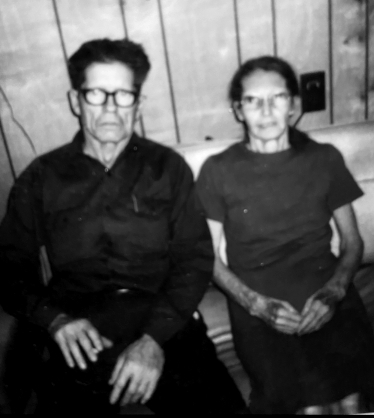
Photo submitted by Derrick Lawson
Ott Kemper Lawson b. 15 Oct 1919, d. 28 Jun 1980
Della Lee Morris b. 6 May 1919, d. 19 Nov 1992
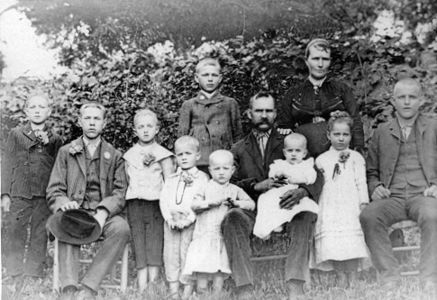
William and Delia Lawson Coleman Family
Front row (seated l-r): Tom, Bill, Joe, Bernard, Dad, Jesse, Amanda, Jack
Back row (standing l-r): Theo, Herbert, Mother
Photo submitted by Jeanette Pryor
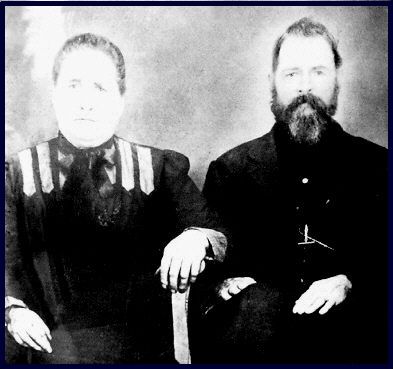
Charles Davis and wife, Columbia Jane Shifflett
Photo provided by Laban West

Roadside School, Beldor Hollow, March 2002
Many of the Lawsons went to this school

Episcopal Mission Home at Simmon Gap, constructed 1900.
Center of Activities every Sunday on Top of the Mountain

Roberta Lawson, born 1869 and her
brother Joseph, born abt. 1874

Rosa Lee Shiflett, born 1884 |

Ida Jane Shiflett, born 1890 |

Following photos provided by John and Janet Thompson
(Eliza J. Lawson and Henry Timber Frazier Family)
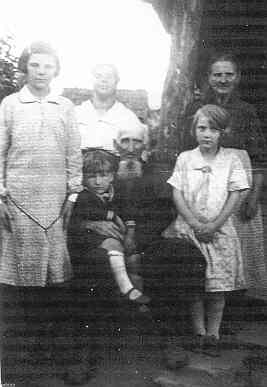 |
L. to R. Back - Mary Shiflett, d/o Lucy Shiflett, Susan Frazier, Eliza Lawson Frazier
Center - Henry Timber Frazier holding one of William Frazier's children, right another one of William's children |
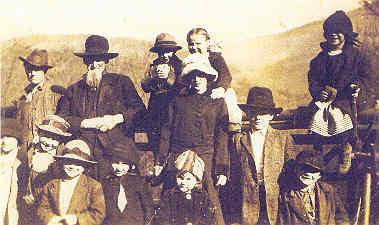
|
L to R - Back: Thomas Shifflett, Henry T. Frazier, Mickleberry Roach, Nora Roach, Della Frazier
Center: Margaret "Maggie" Shifflett (white hat)
Front: Lewis Frazier, Delmus Frazier, Alex Frazier, unknown, Mary Sfifflett, Elsa McCoulay, Othel Frazier
|
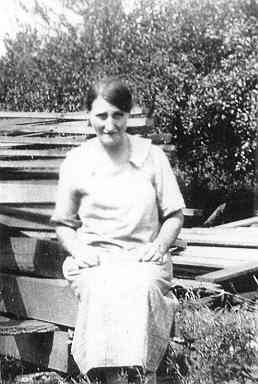
Caroline Frazier |
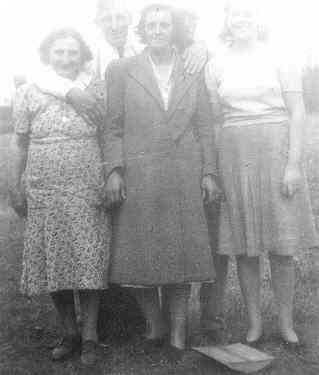 |
| L. to R. Caroline Frazier Shifflett, Henry B. Shifflett, Gertie Shifflett, John W.L. Shifflett, Dorothy Shifflett (Gertie daughter) |
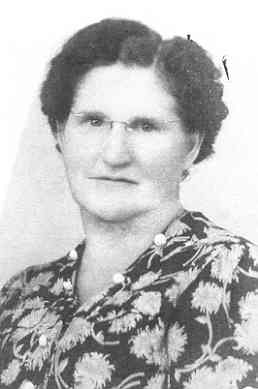
Sarah J. Frazier |
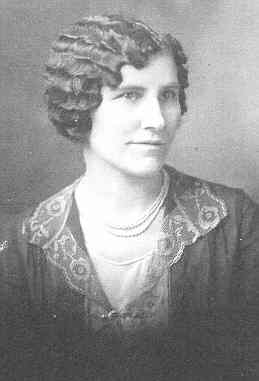
Lillian N. Frazier |
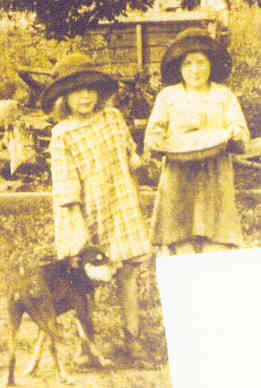
Ida Shiflett and Margaret "Maggie" P. Shifflett (with pan)
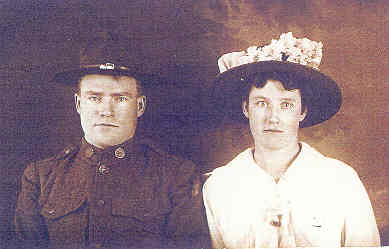
Andrew and Minerva Frazier
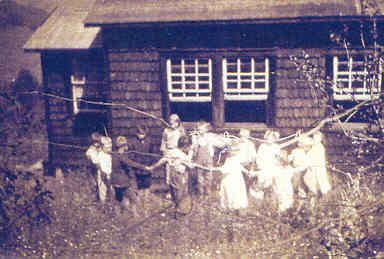
Frazier Mountain School - 1917 Lewis Frazier, age 6, is one of the students
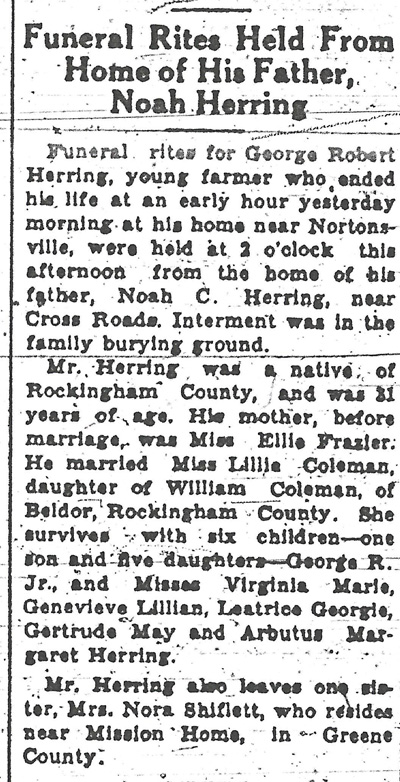
Obituary for George Robert Herring from
The Daily Progress, Charlottesville, VA
Submitted by Norm Addington
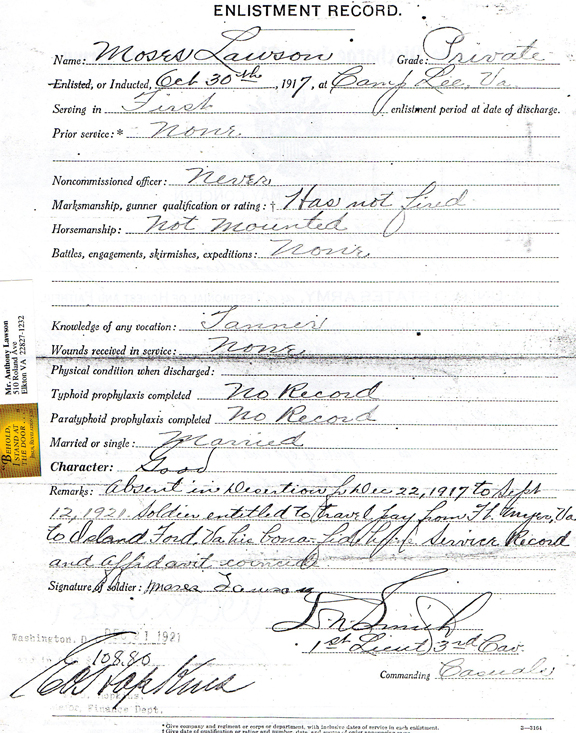
Army enlistment record submitted by Tony Lawson |
|
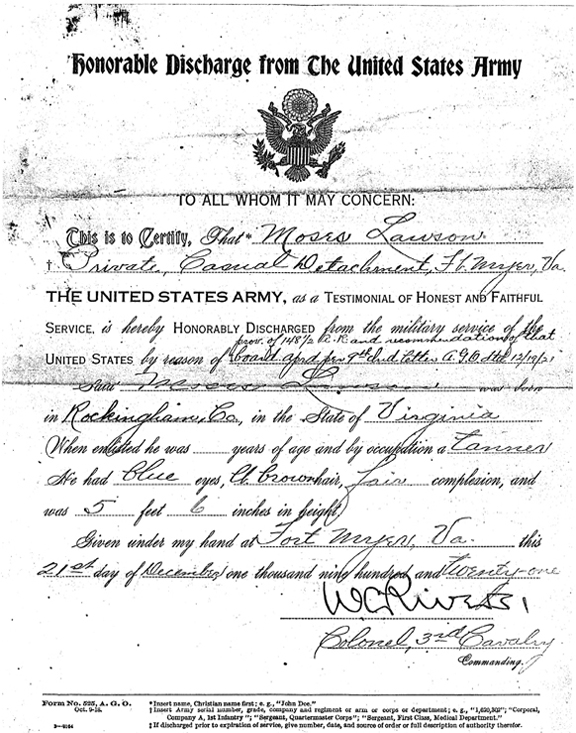 Army discharge record submitted by Tony Lawson
Army discharge record submitted by Tony Lawson
|
|
BACK to Lawson Chart

©1996 - 2002 Copyright for these pages and the information contained thereon lies with the submitter or maintainer named on each page. Reproduction or commercial use of any kind is strictly and expressly prohibited.
This page is part of the Shiflet Family Genealogy Website and is maintained by:
Julia Crosswell / Fort Worth, TX /
Bob Klein / Pasadena MD /



































